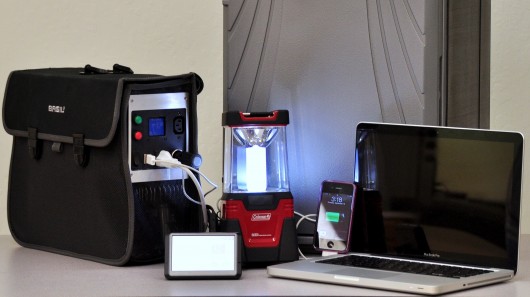SiGNa's portable hydrogen power solution due out soon
16:13 June 5, 2012

SiGNa Chemistry has received funding from USAID to develop portable hydrogen fuel technology, such as the DPS 300 hydrogen generator (left)
SiGNa Chemistry, a company developing portable hydrogen fuel technology, is close to taking one of its solutions to market. Hydrogen is an emissions-free renewable source of energy – however, logistic obstacles related to current considerations such as high-pressure tanks, and metal and chemical hydrides, have stymied its progress towards the mass market.
SiGNA’s solution uses sodium silicide (NaSi) to produce clean hydrogen gas in real time, in response to fuel cell demand at pressures smaller than those found in a common soda can. Sodium silicide is a non-flammable, air-stable powder that instantly reacts with water (or water solutions, including urine) to form pure hydrogen. It is more efficient than pure sodium and safer than other materials because it does not store hydrogen. SiGNa’s development activities focus primarily on the sodium silicide cartridges, which are designed to be integrated with any fuel cell system, although the company has developed its own fuel cell systems for demonstration purposes.
SiGNa has three main solutions in development and the one closest to market is the PowerTrekk, which should be going on sale by August from outdoor gear REI stores, although it had been expected last October. Designed by Swedish company myFC, the 2-in-1 device features a fuel cell battery pack and replaceable fuel cartridges. Each fuel cartridge weighs 30 grams (1.05 oz) and has an indefinite shelf life.
PowerTrekk is designed to work anywhere and power all types of electrical devices that require less than 4W, including cell phones, cameras, iPods, GPS systems, and PDAs. SiGNa says that each fuel cartridge provides up to four hours of energy and costs less than a 4-pack of AA batteries. The fuel cartridges are manufactured with sustainable materials and are fully recyclable.
The company is also developing the DPS 300, a hydrogen generator that works very similarly to a traditional gas generator or battery-powered uninterruptable power supply. It was developed with help from The United States Agency for International Development (USAID) after SiGNa received Stage 1 funding in 2010. Again, the user simply needs to add water, and the sodium silicide fuel cartridges will instantly produce the hydrogen that allows the fuel cell to create electricity. SiGNa says it is six times cheaper, much lighter, and smaller than existing battery technology. It could power any device that requires less than 250W, including phones, computers, water filters and small fridges. The device is a tough little number that can endure extreme temperatures (-10°C to + 50°C, or 14ºF to 122ºF), which makes it an ideal solution for people living in zones without connection to an electric grid.
Cyclists can also look forward to SiGNa’s hydrogen-powered future as the company has created a fuel cell to power electric bikes from Pedego. The power platform, called range extender, instantly produces hydrogen gas and converts hydrogen to electricity, estimated at up to 200W of continuous power. The fuel is stored in hot-swappable light fuel cartridges that weigh 1.5 pounds (0.68 kg). Excess energy is stored in a lithium battery for use in more energy-intensive conditions, such as steep tracks. It increases the current e-bike standard of 20 miles (32 km) without pedaling to more than 60 miles (96.5 km) for each carried cartridge.
Best of all, the only other emission apart from water vapor generated by hydrogen is the cyclist’s perspiration.
Source: SiGNa
Copyright © gizmag 2003 - 2012 To subscribe or visit go to: http://www.gizmag.com